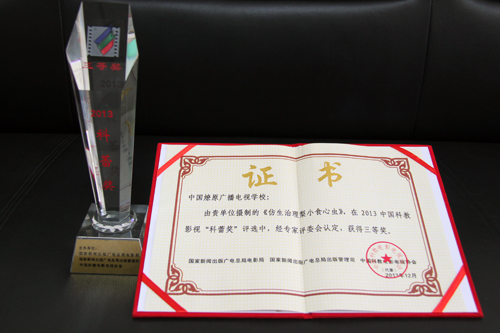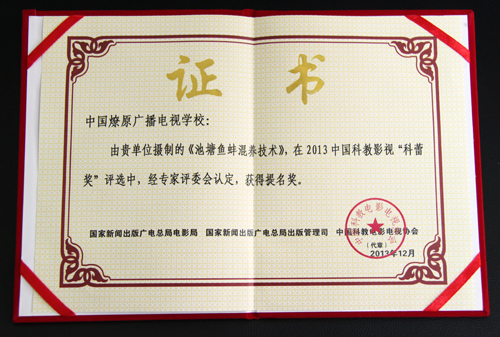
The selection results of the Seventh Kelei Award for China Science Films and Videos were recently unveiled. The event was jointly sponsored by the Film Bureau of State Administration of Press, Publication, Radio, Film and Television, China Science Film and Video Association, and Chinese Association of Natural Science Museums. The award ceremony was held at the China Hall of Science and Technology on December 17. Two excellent TV teaching programmes recommended by China Liaoyuan Radio and TV School of the Open University of China (OUC) received awards: “Bionic” Control of Oriental Fruit Moth won third prize, and Pond Polyculture Technique of Fish and Clams won nomination prize.

“Bionic” Control of Oriental Fruit Moth introduces the moth's distribution and harmful effects, identifying features, annual history, control methods, effects of various control methods (pest monitoring, mass trapping, and isotropy control), and supplementary methods for controlling the spread of the oriental fruit moth. The picture integrated macro photography and computer animation in its presentation. Pond Polyculture Technique of Fish and Clams mainly introduces fish pond conditions for fish-clam polyculture, conditions for pearl cultivation and the specific operational steps, the choice of clams for farming, preparation for cultivation, slice preparation, post-operation recuperation, hanging of pearl clams, fry stocking, management of pearl clams, pest control for pearl clams, and collection of pearl clams.
The Kelei Award for China Science Films and Videos is an authoritative professional award with extensive influence in the national society of science films and videos. As a biannual event, this year marks the seventh selection. 165 works were solicited nationwide from provincial and municipal TV stations, audio-visual centres of different ministries and commissions, and multimedia production companies, with 2 special awards, 6 first prize awards, 12 second prize awards, 24 third prize awards, and 51 nomination awards.
China Liaoyuan Radio and TV School was established through the former China Central Radio & TV University (now The Open University of China ) by the Ministry of Education (the former State Education Commission) for cooperation with the implementation of the Prairie Fire Programme in April 1990. It is a school oriented to conduct rural distance education by utilizing various multimedia means such as radio, TV, print, and audio-visual teaching materials. Following its establishment, about 20 provincial and municipal Liaoyuan schools were successively set up. In better developed areas, Liaoyuan schools were also established at the county and township levels, forming a Liaoyuan education network utilizing TV programmes as the major teaching media. By making use of the TV teaching programme resources of China Liaoyuan Radio and TV School, local Liaoyuan schools are able to actively educate students via organized viewing of these programmes, bringing practical technical programmes to the countryside, distributing booklets on agricultural technology, opening Liaoyuan education training classes, and building Liaoyuan demonstration projects. In this way, programmes on practical technique can reach thousands of households.
Ever since its establishment, China Liaoyuan Radio and TV School has produced TV teaching programmes totaling over 4,000 credit hours, which are broadcast on the first and second channels of China Education TV Station. Meanwhile, it also undertakes the task of producing and broadcasting vocational education programmes via these methods for the national Party cadres for the Organization Department of the Central Committee of the CPC, completing resources of about 220 credit hours each year. In addition, it joined in the construction of video resources for the cultural information resources sharing project launched by the Ministry of Culture.
By Yang Lizhi ,the OUC